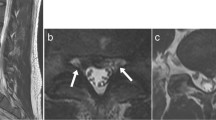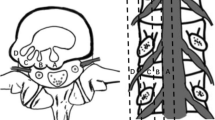Summary
The aim of our study was to evaluate the contrast-enhanced MR imaging (MRI) findings, in the early postoperative period, in unselected patients undergoing lumbar microdiscectomy (15/16 had total resolution of their symptoms). Contrast-enhanced imaging studies were performed, in all 16 patients of our series, before surgery, and at the third postoperative day and, two months after surgery. Postoperative paraspinal muscles enhancement was present in all patients. In the postoperative period, nerve root enhancement was present in 5/16 patients at the early survey and persisted in one after two months. A pseudohernia depicted as epidural intermediate signal intensity tissue, was seen in 13 patients at the third day MRI, and only in eight after two months. This pseudohernia enhanced peripherally in 8/13 patients and enhanced homogeneously in the remaining five at the first postsurgical examination; in the late MRI the peripheral enhancement was appreciable in only two patients while a homogeneous enhancement was observed in six.
Clinical symptoms resolved completely in 14/16 patients on clinical evaluation at the third postoperative day, while the remaining two patients showed residual symptoms and signs of radicular compression. At the early MRI these two patients showed intradural nerve root enhancement. Two months later, one patient did not show the previously described nerve root enhancement and improved clinically, while the other had a positive Straight Leg Raising Sign with persistent intradural nerve root enhancement. In conclusion, no correlation between clinical course and contrastenhancement of pseudohernia and extradural nerve root was appreciable, although intradural nerve root enhancement seems to represent a clinically relevant finding.
Similar content being viewed by others
References
Boden SD, Davis DO, Dina TS, Parker CP, O'Malley S,et al (1992) Contrast-enhanced MR imaging performed after successful lumbar disc surgery: prospective study. Radiology 182: 59–64
Braun IF, Hoffman JC, Davis PC, Landman JA, Tindall GT (1985) Contrast enhancement in CT differentiation between recurrent disc herniation and postoperative scar: prospective study. AJNR 6: 607–612
Bundschuh CV, Stein L, Slusser JH, Schinco FP, Ladaga LE, Dillon JD (1990) Distinguishing between scar and recurrent herniated disc in postoperative patients: value of contrastenhanced CT and MR imaging. AJNR 11: 949–958
Burton CV, Kirkaldy-Willis WH, Yong-Hing K, Heithoff KB (1981) Causes of failure of surgery on the lumbar spine. Clin Orthop 157: 191–199
Cavanagh S, Stevens J, Johnson JR (1993) High resolution MRI in the investigation of recurrent back pain after lumbar discectomy. J Bone Joint Surg 75B: 524–528
Deutsch AL, Howard M, Dawson EG, Goldstei TB, Mink JH, Zeegen EH, Delamarter RB (1993) Lumbar spine following successful surgical discectomy. Magnetic resonance imaging features and implications. Spine 18: 1054–1060
Firoozina H, Kricheff II, Rafii M, Golimbu C (1987) Lumbar spine after surgery: examination with intravenous contrastenhanced CT. Radiology 163: 221–226
Floris R, Spallone A, Aref TY, Rizzo A, Apruzzese A, Mulas M, Simonetti G (1997) Early postoperative MRI findings following surgery for herniated lumbar disc. Acta Neurochir (Wien) 139: 169–175
Green LN (1975) Dexamethasone in the management of symptoms due to herniated lumbar disc. J Neurol Neurosurg Psychiatry 38: 1211–1217
Hueftle MG, Modic MT, Ross JS,et al (1988) Lumbar spine: postoperative MR imaging with Gd-DTPA. Radiology 167: 817–824
**kins RJ, Osborn AG, Garret D, Hunt S, Story JL (1993) Spinal nerve enhancement with Gd-DTPA: MR correlation with the postoperative lumbosacral spine. AJNR 14: 383–394
Kotilainen E, Alanen A, Erkintalo M, Helenius H, Valtonen S (1994) Postoperative hematomas after successful lumbar microdiscectomy or percutaneous nucleotomy; a magnetic resonance study. Surg Neurol 41: 98–105
Kotilainen E, Alanen A, Erkintalo M, Valtonen S, Kormano M (1994) Magnetic resonance imaging changes and clinical outcome after microdiscectomy or nucleotomy for raptured disc. Surg Neurol 41: 432–440
Mackinnon SE, Dellon AL, Hudson AR, Hunter DA (1984) Chronic nerve compression: an experimental model in the rat. Ann Plast Surg 13: 112–120
Modic MT, Masaryk TJ, Ross JS, Carter JR (1988) Imaging of degenerative disc disease. Radiology 168: 177–186
Olmaker K, Rydevik B, Holm S, Bagge U (1989) Effects of sperimental graded compression on blood flow in spinal nerve roots: a vital microscopy study on the porcine cauda equina. J Orthop Res 7: 817–823
Rechthand E, Smith OR, Rappaport SI (1987) Transfer of nonelectrolytes from blood into peripheral nerve endoneurium. Am J Physiol 252: H1 175-H1 182
Ross JS, Masaryk TJ, Modic MT, Bohlman H, Delamater R, Wilber G (1987) Lumbar spine: postoperative assessment with surface-coil MR imaging. Radiology 164: 851–860
Ross JS, Masaryk TJ, Schrader M, Gentili A, Bohlman H, Modic MT (1990) MR imaging of the postoperative lumbar spine: assessment with gadopentate dimeglumine. AJNR 11: 771–776
Rydevik B, Brown MD, Lundborg G (1984) Pathoanatomy and pathophysiology of nerve root compression. Spine 9: 7–15
Soitropoulos S, Chafez NI, Lang P,et al (1989) Differentiation between postoperative scar and recurrent disc herniation: prospective comparison of MR, CT, and contrast-enhanced CT. AJNR 10: 639–643
Spallone A, Martino V, Floris R (1993) The role of early postoperative CT-scan following surgery for herniated lumbar disc. Acta Neurochir (Wien) 123: 52–56
Tullberg T, Grane P, Rydberg J, Isacson J (1994) Comparison of contrast-enhanced computed tomography and gadoliniumenhanced magnetic resonance imaging one year after lumbar discectomy. Spine 19: 183–188
Williams RW (1978) Microlumbar discectomy. A conservative surgical approach to the virgin herniated lumbar disc. Spine 3: 175–182
Author information
Authors and Affiliations
Rights and permissions
About this article
Cite this article
Floris, R., Spallone, A., Aref, T.Y. et al. Early postoperative MRI findings following surgery for herniated lumbar disc part II: A gadolinium-enhanced study. Acta neurochir 139, 1101–1107 (1997). https://doi.org/10.1007/BF01410968
Issue Date:
DOI: https://doi.org/10.1007/BF01410968




